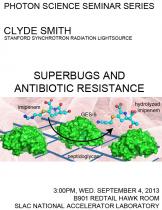Clyde Smith, SSRL
The emergence of bacteria resistant to important classes of antibiotics has become a major clinical problem over the last few years, and now almost all antibacterial compounds in use today have associated examples of resistant bacterial isolates. Resistance to penicillins for example has been known since the late 1940’s, not long after these compounds were first introduced as antibiotics towards the end of WWII. Today a large number of bacterial strains are resistant to penicillin and more recent derivatives such as methicillin, cephalosporins and carbapenems. Resistance is primarily due to the production enzymes which disrupt the structure of the penicillin molecules. Drug inactivation is also the major cause of resistance in Enterococci. In the United States, these are among the most common resistant bacteria isolated in nosocomial infections. The synergistic use of ampicillin or vancomycin with an aminoglycoside (kanamycin or gentamicin), has long been the optimal therapy for enterococcal infections, but many previously susceptible strains have since acquired resistance to the aminoglycosides. Resistance arises by horizontal gene transfer from other bacteria, these genes coding for enzymes that deactivate the antibiotics by chemically altering specific groups on the drug. We have actively working on determining the high resolution crystal structures of enzymes which deactivate the penicillins (the β-lactamases) and aminoglycosides (the aminoglycoside phosphotransferases and aminoglycoside acetyltransferases). The modes of bacterial antibiotic resistance will be discussed and some structures bacterial antibiotic resistance enzymes will be presented.





